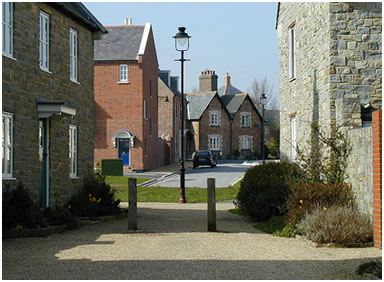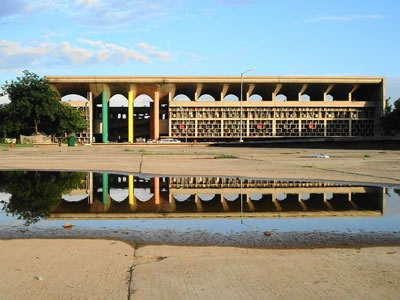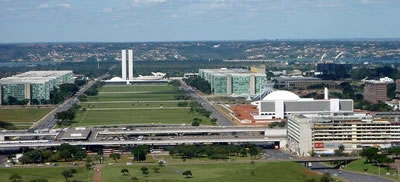Less than a year ago, Gordon Brown’s government announced that ten “eco-towns” would be built on various sites across Britain. These towns were to have been sponsored by state largesse, but developed by institutions from the Co-Operative Society to Tesco – PFI cities, if you will. These settlements of around 50,000 people were designed to be self-sufficient and “carbon neutral”. Protests ensued almost immediately in practically all of the areas that were slated to have an eco-town next door, with cries of distress from a motley selection of taste leaders all the way from Judi Dench to Tim Henman’s Dad.
 There’s little doubt that eco-towns were more about property speculation than they were a product of ecological enthusiasm, and there was much justified criticism that these were disguised commuter suburbs, with no infrastructure and no industry.
There’s little doubt that eco-towns were more about property speculation than they were a product of ecological enthusiasm, and there was much justified criticism that these were disguised commuter suburbs, with no infrastructure and no industry.
Yet the opposition seemed driven more by hatred of the idea of city-dwellers ruining what Clive Aslet, ex-editor of Country Life, recently called (on the subject of Milton Keynes) “22,000 acres of formerly good hunting land”. On a protest in front of Parliament, some held up placards declaring that these Eco-Towns were mere “New Towns”. And apparently we all know what that means. Milton Keynes, Stevenage, Harlow, Cumbernauld, Runcorn . . . mid-century towns full of “eyesores” and concrete cows, bereft of the “heritage” that so obsesses the British psyche. It became clear that these people hated the very idea of New Towns, of the dispersal of people across what is, in terms of space, if not population, a still overwhelmingly green country.
There’s something rather sad about this reaction. In essence, the conviction is that any new town which stressed its “newness” would necessarily be “soulless” or “ugly”. It’s notable that the only major New Town begun since the late 1960s is Prince Charles’ pet project, Poundbury. Its planner Leon Krier is an apologist for the Nazi architect and politician Albert Speer, whose pompous classical edifices would, if Hitler had won the war, have transformed Berlin from a modern metropolis into the neoclassical showpiece “Germania”.
Speer wanted to design new buildings that somehow didn’t look new – a “theory of ruin value” that has been embraced in Prince Charles’ new town, where buildings are apparently pre-distressed to give them an old, distinguished appearance, and where any technological innovation post-1780 is verboten. So what of the New Town? Might it actually be the case that the humanist impulse would be to deliberately design a place for people’s actual needs, as opposed to putting up with the accidents of history and land values? To build such a place is a very Enlightenment idea, and it’s one worth re-evaluating today, rather than dismissing it out of hand as “concreting over the countryside”.
The 18th century produced model towns as diverse as Washington and Bath, all of them based on vistas, clean lines, an urban representation of scientific and mathematical concepts. Yet most were New Towns for the rich, those who could afford the new spaces’ light, air and openness. The late 19th century saw contrite industrialists plan ideal settlements like Port Sunlight or Bourneville; and in the 1900s-20s Ebenezer Howard, a very late-Victorian combination of crank and pragmatist, pioneered the garden cities of Letchworth and Welwyn. Yet when people talk about New Towns they don’t mean the garden cities, which, like precursors to Poundbury, used antiquated materials and winding street patterns in order to simulate historical accident. Rather, they mean the postwar New Towns. They mean concrete precincts, glass shopping centres, flat-roofed houses and roundabouts. They mean Cumbernauld, with its central shopping centre that was an architectural cause celèbre for a few years and an “eyesore” for decades more; they mean Crawley or Stevenage, towns which were intended to be self-sufficient but became just another part of the commuter belt.
 Apparently these places are alienating, cold, bland – while presumably unplanned suburbia or simulations of “heritage” are the apex of what a town could be. A new book, Le Corbusier and Britain, edited by Irena Murray and Julian Oxley, provides a fascinating insight into what exactly worries the British about all this. Although the Swiss architect – currently undergoing one of his periodic revivals – never built anything here, his ideas for new towns and cities have been a constant source of fascination and horror since the 1920s. One look at many of these – the Ville Contemporaine of 1922, or the famous Ville Radieuse of 1933 – and it’s easy to see why. Although they were designed as alternatives to sprawl, overcrowding and disease, they’re a little terrifying. Endless tower blocks, glass skyscrapers, motorways and walkways, with nothing irregular or old left standing. In Le Corbusier and Britain, you can find typical English conservatives such as Evelyn Waugh or the architect Edwin Lutyens – who was designing the imperialist utopia of New Delhi at the time – reading Corbusier with interest, but with no doubt about the uselessness of his ideas. For Lutyens these were cities fit only for robots, and for Waugh an example of “incisive Gallic logic” which ignored the passage of time, “when the patina of the concrete has weathered and the sharp angles have softened”. Leon Krier made a similar remark recently about Milton Keynes, which he claimed would become entirely obsolete in a society which eschewed the use of fossil fuels.
Apparently these places are alienating, cold, bland – while presumably unplanned suburbia or simulations of “heritage” are the apex of what a town could be. A new book, Le Corbusier and Britain, edited by Irena Murray and Julian Oxley, provides a fascinating insight into what exactly worries the British about all this. Although the Swiss architect – currently undergoing one of his periodic revivals – never built anything here, his ideas for new towns and cities have been a constant source of fascination and horror since the 1920s. One look at many of these – the Ville Contemporaine of 1922, or the famous Ville Radieuse of 1933 – and it’s easy to see why. Although they were designed as alternatives to sprawl, overcrowding and disease, they’re a little terrifying. Endless tower blocks, glass skyscrapers, motorways and walkways, with nothing irregular or old left standing. In Le Corbusier and Britain, you can find typical English conservatives such as Evelyn Waugh or the architect Edwin Lutyens – who was designing the imperialist utopia of New Delhi at the time – reading Corbusier with interest, but with no doubt about the uselessness of his ideas. For Lutyens these were cities fit only for robots, and for Waugh an example of “incisive Gallic logic” which ignored the passage of time, “when the patina of the concrete has weathered and the sharp angles have softened”. Leon Krier made a similar remark recently about Milton Keynes, which he claimed would become entirely obsolete in a society which eschewed the use of fossil fuels.
On the other hand, Britain saw, in the 1940s and 1950s, some of the most impressive take-ups of Le Corbusier’s ideas for new spaces, though initially they drew on what gets ignored by those who see Corbusier as a demented creator of urban blight – that is, the demand in the Ville Radieuse that 95 per cent of the town should be parkland, with buildings set in them in irregular arrangements. In 1951, the first residential tower block in Britain was designed for the New Town of Harlow. This was one of a series of towns planned in the 1940s by the Labour government of Clement Attlee, for rehousing the former inhabitants of bombed-out east London. The tower wasn’t part of some bleak urban vista – the area around was as green as any garden city, and surrounded by one-storey houses with gardens. This suggests that the received idea of the New Town is a rather superficial one – tower blocks and a lack of old churches or Victorian edifices do not automatically equate to inhumanity.
 Le Corbusier and Britain
Le Corbusier and Britain
Yet Brasilia is usually taken to be an act of sheer hubris, a third world city based on the idea that everyone would own a car, its grid pattern and open spaces an example of humanist rationalism taken to an irrational extreme, with the elegance of the design compromised by the omnipresent traffic. Brasilians have long since reconfigured their blocks of flats to give them the bustling streets denied by the original plan. Brasilia never became the classless capital that the Communist Niemeyer hoped for, and shantytowns sprung up on the outskirts. The architect fled the building site after a military coup in 1964, but even today, he prefers to live in Rio.
It’s unlikely the eco-towns would ever have been as carefully designed as Harlow, let alone on the audacious scale of Brasilia. The argument of many environmentalist opponents that making existing cities more ecologically sound is more important than “zero-carbon” enclaves is pretty indisputable. The Chinese eco-city of Dongtan recently won an award for most impressive “greenwash”, as an unconvincing fig leaf on a huge, unsustainable industrialisation. Yet though some New Towns have succeeded, others have failed, and others become fascinating failures, we’re losing something important with the abandonment of the idea that we could produce something brilliant from scratch. A new place, free of the old city’s cathedrals to finance, power or superstition, should be viewed by humanists with enthusiasm, not with knee-jerk suspicion.

